William H. Cross Expedition, 5 -9 October, 2007, GA., Emanuel Co., Ohoopee Dunes Preserve, Ohoopee Dunes Natural Area and Preserve, George L. Smith State Park, Fall Line Sandhills Natural Area, and Big Hammock Natural Area
by Joe MacGown
This year's William H. Cross Expedition took place from 5 to 9 October, 2007, with our collections being centered primarily around the Ohoopee Dunes Natural Area and Ohoopee Dunes Preserve in Emanuel County, Georgia. We also made collections at George L. Smith State Park in Emanuel County, at Big Hammock Natural Area in Tattnall County, and to a lesser degree, at the Fall Line Sandhills Natural Area in Taylor County. A previous Cross Expedition made to the Ohoopee area in June of 2002 (2002 Cross Expedition) yielded many interesting species. Therefore, we decided to again collect in the area, but at a different time of year. Earlier collections also were made at Ohoopee, Big Hammock, and Fall Line Sandhills Natural Areas by MacGown and Hill in May and July of 2007, while surveying for ants and grasshoppers. Participants of the 2007 Expedition included Richard Brown (MEM director), Terry Schiefer (MEM curator), Joe MacGown (MEM research technician), JoVonn Hill (MEM research associate), SangMi Lee (MEM post doctoral associate), Edda Martinez (Ph.D. student), Xu Zhang (Ph.D. student), and Drew Hildebrandt (carabid guy). John Barone, an ecologist from Columbus State University in Georgia, and Malcolm Hodges (George Nature Conservancy) and Sean Beeching, both lichen researchers, also joined us for some of the trip.
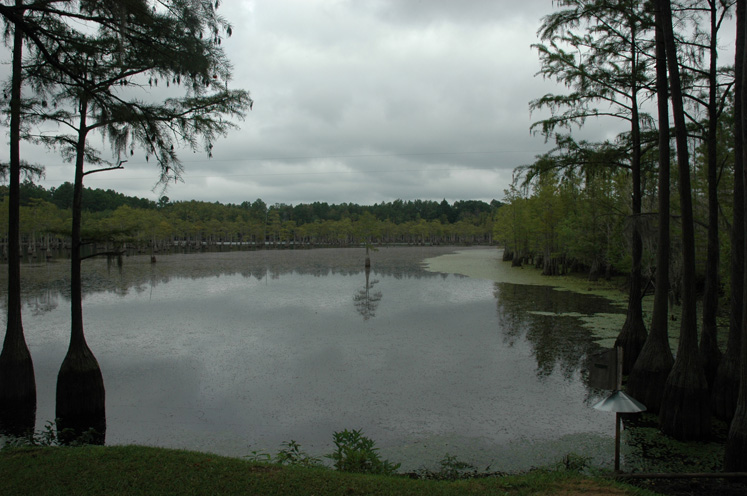
The lake at George Smith State Park
The fall line sandhills originated in the Miocene Epoch about 25 million years ago when they formed the coastline of the Atlantic Ocean. In Georgia, these sandhills are extensive and cross the state from Columbus northeast to Augusta following the fall line, which separates the Piedmont region from the Coastal Plain. The Fall Line Sandhills Natural Area in Taylor County, only recently acquired by the State of Georgia, occupies approximately 876 acres, which is only a small fraction of the fall line sandhills ecosystem. Historically, this area was most likely a mix of oak/pine dune scrub and longleaf pine (Pinus palustris) forests, which were dominated by wiregrass (Aristida stricta) and a myriad of other understory species. However, periodic burns are required for longleaf pine forests to flourish, with the result that only few of these pines are still present today. More recently, much of the property was planted with loblolly pines (Pinus taeda), which have not faired well at all due to the deep sand, which may be up to 25 meters deep . Along the western edge of the property is an open swath that was created by a powerline cut, and in general, the entire tract is quite disturbed. Vegetation on the powerline cut included Rubus sp., Opuntia sp., risky tread softly (Cnidoscolus stimulosus), wiregrass (Aristida beyrichiana), and a variety of other grasses and forbs. Small pockets of oak scrub are still present and are dominated by turkey oak (Quercus laevis), bluejack oak (Q. incana), dwarf post oak (Q. margaretta), loblolly pine, Rubus sp., wiregrass, and an abundance of other plants present as well such as persimmon (Diospyros virginiana), Vaccinium sp., Opuntia sp., little bluestem (Schizachyrium scoparium), risky tread softly, and other species. In addition to the typical sandhill flora and fauna, 11 species of concern are known to occur at the site including 8 animals (such as gopher tortoises) and 3 plants, making this a unique area and an ideal study site for insects as well.
The Ohoopee dunes in Georgia stretch for approximately 35 miles along the Ohoopee River and are about 40,000 acres in totality. Although similar in flora and depth of sand deposits to the Fall Line Sandhills, this unique dune system was formed relatively recently and is believed to have originated during the late Pleistocene (about 20,000 years ago) as a result of sand deposition on eastern and northern banks of the Ohoopee and little Ohoopee Rivers. Much of this land is private; fortunately, two tracts in Emanuel County are protected-the Ohoopee Dunes Preserve (a Nature Conservancy tract) and the Ohoopee Dunes Natural Area. Of these two tracts, which are contiguous, the Nature Conservancy site is the smaller, occupying only 267 acres, whereas the natural area is approximately 1800 acres. The natural area is divided into three main areas: the north, central, and south sites. The plant community of the Ohoopee Dunes is more typical of southeastern coastal communities and consists of a dwarf oak-pine woodland with open patches of xeric dune scrub. Stunted turkey oaks (Quercus laevis), longleaf pines (Pinus palustris), bluejack oak (Quercus incana), and dwarf post oak (Quercus margaretta) are dominant trees. Some of the woody shrubs present include Rosemary (Ceratiola ericoides), seaside, or woody goldenrod (Chrysoma pauciflosculosa), red flowering woody mint (Calamintha coccinea), blueberry (Vaccinium sp.), Clethra alnifolia, and Cyrilla racemiflora. Common herbaceous plants in the natural area include such species as gopher apple (Licania michauxii), sand chickweed (Arenaria sp.), nailwort (Paronychia sp.), wire plant (Stipulicida setacea), goat's rue (Tephrosia virginiana), sand spikemoss (Selaginella arenicola), Amsonia ciliata, Baptisia perfoliatum, Lupinus diffusus, and many others. Various mosses and lichens are abundant, and in some areas form a rough carpet upon the sandy floor. Gopher tortoise burrows are in abundance at the site as well.
The Big Hammock Natural Area is located along the northeast bank of the Altamaha River in Tattnall County, Georgia. The natural area occupies approximately 800 acres and adjoins the Big Hammock Wildlife Management Area (WMA), which encompasses 6,177 acres. Although the WMA is comprised primarily of bottomland hardwood forest with oxbow lakes and sloughs, much of the natural area is a sand ridge that includes a variety of habitats such as cypress/gum forest and turkey oak-sand live oak forest. The sandhill ridge is similar to the Ohoopee dunes in that it is of riverine origin, and was formed more recently. The sandhill habitat was dominated by evergreen oaks, especially turkey oak (Quercus laevis), sand live oak (Q. geminata), and myrtle oak (Q. myrtifolia), some of which were festooned with Spanish moss; palmettos (Serenoa repens); woody goldenrod (Chrysoma pauciflosculosa); sparkleberry (Vaccinium arboreum); and a variety of lichens. Also found in the area was a rare endemic shrub, Georgia plume (Elliottia racemosa).
Our base of operations was one of the new, and quite nice, cabins in George L. Smith State Park. Because we stayed at the park, we also did some collecting there, both in the mesic hardwood forest behind the cabin area and new the lake, and in a sandhill habitat that was quite similar to the Ohoopee Dunes N. A., both in flora and fauna.
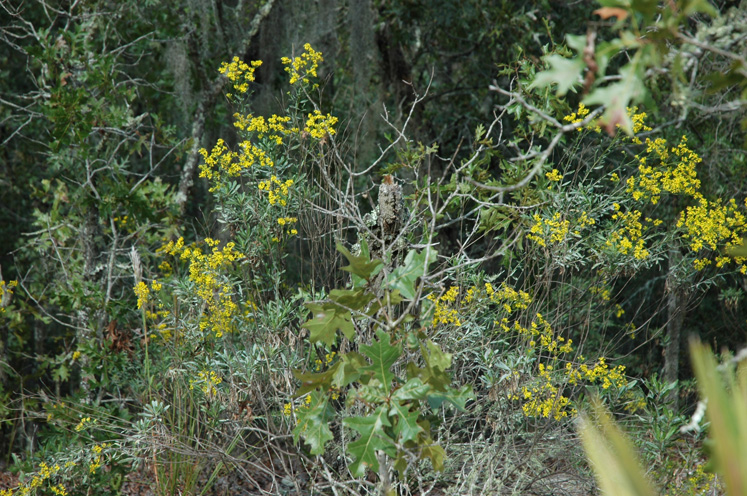
Woody goldenrod at Big Hammock
On the morning of October 5th, we departed from the Mississippi State campus in Starkville, MS to George Smith State Park, a good 8 hour drive. Due to our many supplies, and the fact that some people were leaving early, we took three vehicles. Because JoVonn and I were in one of them, we made a detour and collected for a couple of hours at the Fall Line Sandhills N. A., which ended up being the only collecting we did there on this trip. Although we had already collected there twice earlier in the year, we were curious to see what the place looked like in the Fall. We arrived at about 3:00 P.M with temperatures in the mid 80's F, which seemed quite warm for October. Upon our arrival, we were greeted with an unexpected floral profusion in the open areas which included the sandhill golden aster (Pityopsis pinifolia), blazing star (Liatris sp.), false falseglove (Agalinus sp.), and numerous other wildflowers. While we were there, we collected a variety of ants, bees, grasshoppers, mutillids, beetles, flies, and other insects.
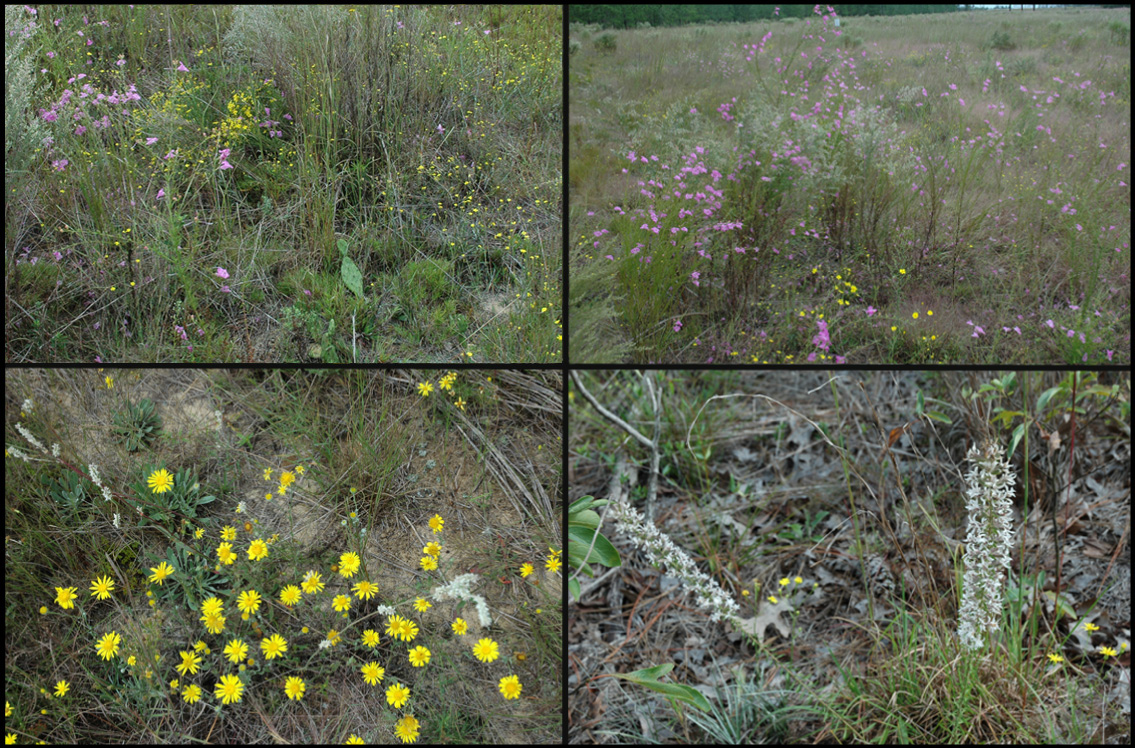
Some of the flowers seen at Fall Line Sandhills Natural Area
Because the daytime collecting was so good, we lamented the fact that we had to get on the road and meet everyone else at the cabin. Considerable insect activity was evident on the ground and on the flowers. Similar to our other excursions to this area, we saw many sand inhabiting ant species such as Dorymyrmex bureni, D. smithi, Pogonomyrmex badius, and Trachymyrmex septentrionalis, and we also found a new species for the site, Aphaenogaster floridana. We were also to observe the presence and collect representatives of a black tiger beetle, Cicindela nigrior, which was rediculously abundant on the powerline cut. Apparently, this Fall species is relatively rare, but can be locally abundant. Individuals were easy, almost effortless to collect, and we didn't even need a net, but simply grabbed them with our hands. After collecting for about an hour at our first stop (site 1), we headed to another part of the natural area (site 2), which appeared to be slightly less disturbed and more dominated by grasses. Along the way, we met a gopher tortoise, who was walking down the middle of the sand road, and I had to get out and move it out of the way. We then made it to our second site and collected for about 40 minutes, before heading on to the state park.
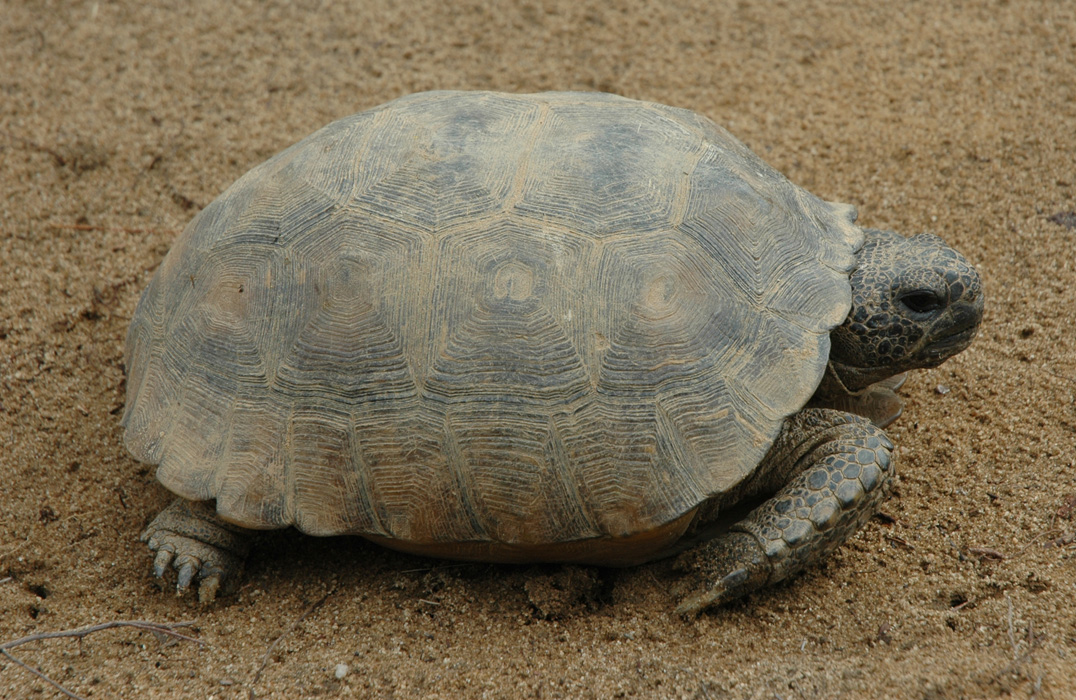
Gopher tortoise
JoVonn and I arrived at the state park at about 7 P.M., only minutes after the rest of the crew. They took a different route, and apparently got delayed a bit in Atlanta. But, there was no time for rest, as we had blacklights to put out for night collecting. We quickly unloaded the truck and got to work. We first put up a sheet with a blacklight and mercury vapor lamp behind the cabin, which was in open mixed mesic habitat that adjoined a cypress-water tupelo edged lake. We then made a mad dash for the Ohoopee Dunes south natural area, which was about 30 minutes away. Along the way it began to rain, and we hoped it would not rain for long. Fortunately, by the time we arrived at 9 P.M., the rain had stopped. We put up three sheets with blacklights along the trail and in the adjacent pine-oak dune woodland, Richard put a blacklight/boxtrap up in the "Bald", and Drew and Terry put two additional boxtraps up in the south natural area. The collecting at the sheets was somewhat limited, in that there was not an abundance of large insects, but there were plenty of minute beetle, microlepidoptera, and assorted other insects. Lots of very long snouted curculionids were present, which we also observed sticking their snouts into green turkey oak acorns still on the trees. In fact, many insects were observed resting on and under leaves of oaks including a wide variety of caterpillars, sulphur butterflies, leaf-footed bug, and grasshoppers. Collections of large lycosid (wolf) spiders were also made at night, with the aid of headlights. These spiders were extremely abundant, and were pale dorsally, but with black blotches ventrally. At approximately 11:30 P.M., we decided to take down the sheets and head back to the cabin, as things had slowed down considerably with a decrease in temperature. Not to mention, we still had a sheet to inspect back at the cabin, which lured in four species of Cerambycididae, much to Terry's delight.
The next morning, 6 October, Richard somehow managed to wrangle SangMi out of her apparent hibernative state, and they went back and picked up the box traps, and even went grocery shopping! Meanwhile, Terry put a Lindgren funnel trap out behind the cabin area. JoVonn and I collected in the wooded area near the cabin. Richard, SangMi, and Edda, spent much of the day sorting through box traps, and collecting in the state park. Terry, JoVonn, and I then headed to the south natural area, where we were going to put up some other traps. When we arrived, we were met by Malcolm and Sean, the lichen hunters. They had already been there a while, and had great success in finding many species. As we looked for potential trap sites, they ambled along with us, frequently getting excited by one lichen or another. Indeed, this sandy wonderland, provided a veritible plethora of lichen species. We ended up putting two of the Malaise traps and two barrier traps up along the trail, and a one malaise and one barrier trap in the "Bald". Terry also put out two Lindgren funnel traps in the pine-oak forest bordering the trail. About the time we finished putting up the traps, it began to rain. After waiting out the rain, we managed to get some collecting done. Although I collected a variety of diurnal insects, I spent much of my time collecting ants. Similar to previous collecting trips, many common sand inhabiting ants, such as Dorymyrmex bureni, Forelius pruinosus, Trachymyrmex septentrionalis, Pogonomyrmex badius, Aphaenogaster floridana, Pheidole davisi, and Pheidole morrisii were found to be common and abundant. Workers of Paratrechina phantasma, which are typically nocturnal, were seen crawling on the sand under the cloudy sky during the day. Searching under a rotting log revealed a colony of army ants, Neivamyrmex opacithorax, which was a new find for the area. The colony was in the soil, litter, and log and occupied a large area, appearing to follow the log for at least three meters. Although these ants are not overly aggressive, they can definitely inflict a painful sting, as I can now attest! I also collected 6 gallons of leaf litter to be run through Winkler extraction sacks back at the cabin. JoVonn also collected a variety of insects, especially ants and grasshoppers, some of which he was quite excited about. As the day wore on, Terry, Malcohm, and Sean went to town for some supper. At approximately 6:00 P.M., the rest of the crew and Terry's group met us at the south site, and brought us supper! We then all departed and headed to the Nature Conservancy site for an evening of blacklighting.
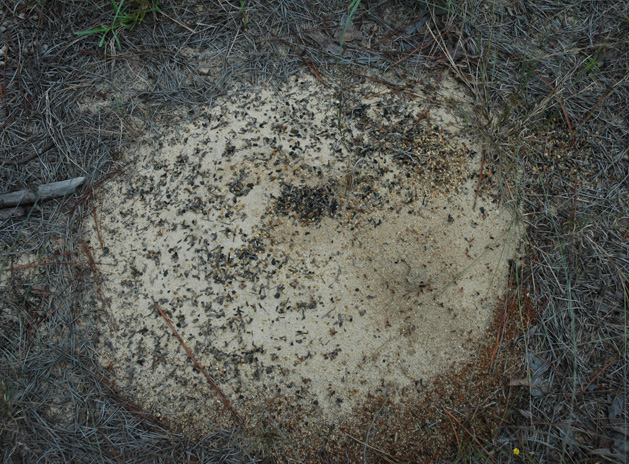
A colony of harvester ants (Pogonomyrmex badius)
After we arrived at the nature preserve, we put up three sheets with blacklights. Additionally, Richard put set up a boxtrap with blacklight and Drew put out two boxtraps. As we were putting up sheets, John Barone showed up to join us. Before dark I collected a few species of ants that were nesting in the sand including Paratrechina phantasma, Trachymyrmex septentrionalis, Aphaenogaster floridana, and Pheidole morrisii. Alates of a few additional species were collected at the sheets, and those species were Forelius pruinosus, Brachymyrmex patagonicus, Camponotus floridanus, Hyponponera opacior, and Tetramorium bicarinatum. Numerous beetles, moths, and other insects were also at the sheet, including an interesting mantid species, Gonatista grisea, the grizzled mantid. As the night wore on John Barone left for his motel, and JoVonn, SangMI, Drew, and I left soon there after and headed back to the state park. When we got back to the cabin, we collected at the sheet there, where we found some different beetles and other insects. Several grizzled mantids were present as well. After checking the sheet, JoVonn and I put the litter from the south natural area into the Winkler sacks. At about 1:00 A.M., the other members of the crew arrived at the state park.
Early the next morning, Richard picked up the box traps from the nature preserve. After eating some breakfast and taking care of some specimens collected the previous night, JoVonn and I collected some insects in the woods near the cabins. About mid-morning we met John Barone and collected in a sandhill habitat in the park, which was very similar to the Ohoopee Area. Vegetation was typical for sandhill habitat and included various oak species such as turkey oak, pines, Opuntia sp., and several common sandhill forbs. Gopher tortoise burrows were in abundance, and two snakes were seen in the area. The ant fauna was similar to that of Ohoopee, but had a stronger presence of some species that tend to inhabit disturbed areas including Dorymyrmex smithi, Brachymyrmex patagonicus, and Solenopsis invicta. However, these species were mostly relegated to the most disturbed parts of the sandhill habitat, such as the powerline cut and the trail. Veering off the trail only a few meters and examining the ground revealed colonies of several interesting sand inhabiting species including Paratrechina phantasma, Monomorium viride, Solenopsis pergandei, Aphaenogaster floridana, Pheidole davisi, and Ph. floridana. After collecting in the sandhill area for a couple of hours, we went back to the cabin for some lunch.
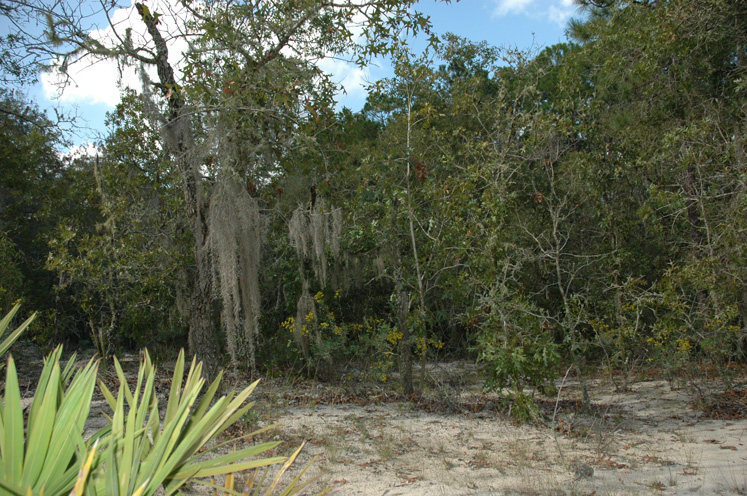
A view of the sandhill habitat at Big Hammock
After lunch, JoVonn, Terry, John, and I made our way to the Big Hammock N.A. in Tatnall County, where we arrived at 2:20 P.M. Sean and Malcolm were already there collecting as many species of lichens as they could. It was quite warm and humid, and throughout the afternoon, cloud cover increased. We got rained on twice, the second time of which proved to be a drenching rain. Sometime before the first rain, John left to head back to Columbus, and Sean and Malcolm left soon after. Despite the heat, humidity, and scattered showers, we were able to collected quite a few insects. Apparently, grasshoppers did not mind the weather at all, as they were plentiful. We checked through the area for ants as well, to see if species present at the site in spring and summer were still present. After searching the area, we again found many of the same species nesting in the sand such as Dorymyrmex bossutus, Forelius pruinosus, Paratrechina phantasma, Monomorium viride, and Trachymyrmex septentrionalis. Just before dark, Richard, SangMi, Edda, and Drew arrived, and we set up three sheets with blacklights. We put two sheets in the open sandhill habitat, and the other one was placed in an adjacent sand live oak forest. Unfortunately, the collecting was not very exciting (possibly due to the high humidy), and we took the sheets down relatively early (about 9:30 P.M).
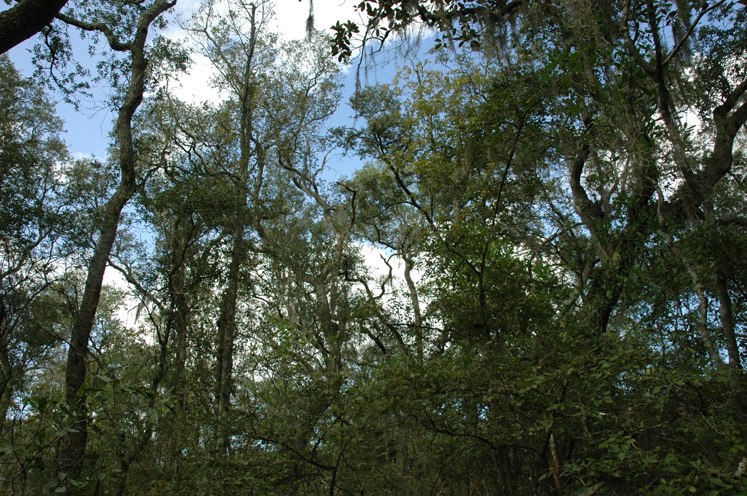
Sand live oak forest at Big Hammock N. A.
The next morning, 8 October, Richard, Drew, SangMi, and Edda headed back to Starkville. SangMi stayed at the cabin to spread as many of the many microleps that she had collected during the week. Terry, JoVonn, and I spent much of the morning and into early afternoon collecting at the sandhill area in the state park. The day started out cloudy and misty, but before long the sun came out and it became hot. Apparently this was good for the bugs, as things were popping. Lots of harvester ant colonies were noted, as were many of the other species of ants. Scattered individuals of the beautiful blueish-green tiger beetle, Cicindela scutellaris scutellaris, were seen moving on the sand, and we collected several specimens; albeit, with considerable effort! Examination of a yellow flowering composite led to the collections of some elongate sphecid wasps and a lepturine cerambycid. Lots of sand wasps were present and we collected representatives of some of those. Perhaps the most interesting catch was a another cerambycid beetle, Tragidion coquus. This species ranges in color from being all black to having the elytra all orange to rusty red. Individuals we collected were mostly black with some orange coloration near the humeral areas of the elytra. I found the first specimen at approximately noon resting near the base of a dead turkey oak, which was approximately 3.8 cm in diameter near the base. Many dead oak of this species and others of similar size were present in the sandhill area lining either side of the powerline cut, and we presumed that they had been herbicided by the power company. After finding the first species, we made a concerted effort to locate a few more by searching these oaks, with the result that we collected a total of seven. A couple of these were collected in flight, and they very much resembled large spider wasps when flying.
Later that evening, we collected at the Ohoopee Dunes North Natural Area. Upon arriving at the site, we met Matt Elliot, the Georgia DNR director (non-game), and talked with him as we collected. Compared to the south area, this area was somewhat reduced, so we only put up two sheets with blacklights. In addition to blacklighting, we also perused the area for ants and other beasts. The pale lycosid spiders with dark undersides were as abundant here as at the other sites. I found a wonderful, smooth-bodied trap-door or related spider while lying on the ground searching through litter for ants. I was lucky that I didn't eat the thing! Plenty of the typical sandhill ants that we had seen at the other sites were present. We found workers of Camponotus socius, an attractive species of carpenter ant, crawling on the ground at night. Following some of them led to a large subterranean nest in the sand. Nests of Aphaenogaster floridana were abundant; and, as night fell, workers of Paratrechina phantasma covered the sandy floor. Before our collections in Georgia, this pale whitish-yellow species was not known to occur in the state. However, we found it to quite common and abundant at all of the Ohoopee sites and the Big Hammock site. An apple core that we had discarded proved to be suitable bait for two ant species, Aphaenogaster treatae and Cyphomyrmex rimosus, the latter of which is an introduced species. The sheets had as many minute beetles as we could possible suck up with our aspirators and a steady supply of moths and other insects. Overall, the blacklighting was much better than the night before. But, near 11:00 P.M. things appeared to be slowing down, and we took down the sheets and headed back to the cabin to check the sheet there.
The next morning, 9 October, JoVonn and I went to the central part of the Ohoopee Dunes N. A. for some day collecting, while Terry went back to the dune site in Smith State Park to collect. SangMi stayed at the cabin to continue pinning the moths she had collected. It was another hot and sunny October day and collecting was again good. Terry picked up another of the Tragidion longhorned beetles and numerous other beetles, wasps, bees, and insects. Meanwhile, JoVonn and I found the ant and grasshopper fauna at the central area to be quite similar to the other sites. Additionally, we noted the presence of the same species of green tiger beetle,Cicindela s. scutellaris, at this site, which for some reason was not seen at the other Ohoopee sites. After spending a few hours collecting, we went back to the park, picked Terry up, and then ate some lunch. Following our meal, we went back to the south natural area to take the traps down and make additional collections. The traps had done their jobs well, as they were all mostly full of insects. Grasshopper activity was high, and we collected several good species for the area. While walking down the trail in the Bald area, we noticed many narrow squiggly "trails" on the sand, which led to small depressions. Digging out on of these depression revealed the presence of a large antion, or "doodlebug" (so called because of the doodles that they make in the sand).
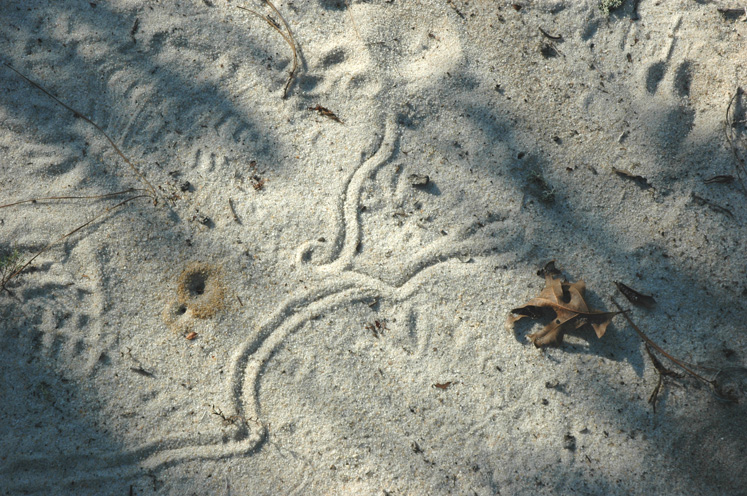
Tracks of an antlion (doodlebug)
After we got through taking down all of the traps and collecting, we left the natural area and headed back to pick up some supper for SangMi and ourselves. We arrived back at the cabin well after dark, ate our supper, and then blacklighted for one last night. Because we were all fairly worn out by this point, we decided to simply blacklight at the sheet behind the cabin. Collecting was relatively good and steady, until eventually we got tired, and took down the sheet and lights. We packed much of the equipment, to make our early morning departure much smoother, and then hit the sack. Early the next morning (10 October), we loaded the truck and headed back to Mississippi State University. And thus, another Cross Expedition had come to a sucessful conclusion.
LOCALITY DATA AND HABITAT INFO
George L. Smith State Park Sites
George L. Smith State Park, cabin area (new cabins) Blacklight & MV lamp at sheet, 1 Lindgren funnel, general collecting
GA.,Emanuel Co.
George L.Smith St. Pk.
32°33'15"N82°07'22"W
mesic hardwood forest (ants and Lindgren)
mixed mesic forest (lights and cabin)
George L. Smith State Park, nature trail-dune habitat, general collecting
GA.,Emanuel Co.
George.L.Smith St. Pk.
32°32'44"N82°07'21"W
pine-oak dune woodland
Ohoopee Dunes Natural Area
South Natural Area Loop road and north side of road (2 malaise traps, 2 Lindgrens, 2 barrier traps, blacklight sheeting)
GA., Emanuel Co.
Ohoopee Dunes N.A.
32°31'51"N82°27'23"W
pine-oak dune woodland
South Natural Area (Bald) (1 malaise trap, 1 barrier trap, 1 box trap)
GA., Emanuel Co.
Ohoopee Dunes N.A.
32°32'15"N82°27'40"W
xeric dune scrub
Central Natural Area
GA.,Emanuel Co.
Ohoopee Dunes N.A.
32°34'32"N82°26'33"W
pine-oak dune woodland
North Natural Area
GA.,Emanuel Co.
Ohoopee Dunes N.A.
32°34'31"N82°26'30"W
pine-oak dune woodland
Ohoopee Dunes, Nature Conservancy Site
GA., Emanuel Co.
Ohoopee Dunes Pres.
32°31'17"N82°26'42"W
pine-oak dune woodland
Big Hammock Natural Area
GA, Tattnall Co.
Big Hammock N.A.
32°51'55"N82°02'59"W
pine-oak sandhill
Fall Line Sandhills
Fall Line Sandhills-Site 1--5 Oct. 2007, J. A. MacGown, J. G. Hill
GA, Taylor Co.
Fall Line Sandhills N.A.
32°34'37"N84°17'25"W
fall line sandhills
Fall Line Sandhills-Site 4-5 Oct. 2007, J. A. MacGown, J. G. Hill
GA, Taylor Co.
Fall Line Sandhills N.A.
32°34'37"N84°16'24"W
pine-oak sandhill habitat
Habitats
Pine-Oak dune woodland or dwarf oak forest (at Ohoopee & State Park)
Xeric dune scrub or rosemary bald or dwarf oak-evergreen shrub forest (at Bald at Ohoopee)
hardwood bluff forest (at edge of Nature conservancy dunes area)
mixed forest (behind cabin at State Park)
Plants collected on or in
Trees
Quercus incana (bluejack oak)
Quercus laevis (turkey oak)
Quercus margaretta (dwarf post oak)
Pinus palustris (longleaf pine)
Shrubs
Bumelia sp.
Calamintha coccinea (red flowering woody mint)
Ceratiola ericoides (rosemary)
Chrysoma pauciflosculosa (woody goldenrod)
Clethra alnifolia
Cyrilla racemiflora
Polygonella polygama (jointweed)
Vaccinium arboreum (sparkle berry)
Vaccinium stamineum (deerberry)
Vaccinium tenellum (blueberry)
Herbaceous Plants
Arenaria sp. (sand chickweed)
Amsonia ciliata (a little ciliate-leaved plant)
Aureolaria pectinata (false foxglove)
Baptisia perfoliatum
Cnidoscolus stimulosus (risky treadsoftly, a stinging plant)
Licania michauxii (gopher apple)
Lupinus diffusus
Paronychia sp. (nailwort)
Selaginella arenicola (sand spikemoss)
Stipulicida setacea (wire plant)
Tephrosia virginiana (Goat's rue)


